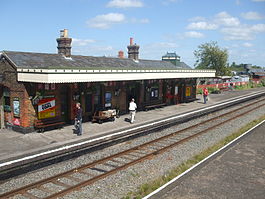Quainton Road railway station
| Quainton Road | |
|---|---|

Up (southbound) platform and the main station building
|
|
| Location | |
| Place | Quainton |
| Area | District of Aylesbury Vale |
| Grid reference | SP738189 |
| Operations | |
| Original company | Aylesbury and Buckingham Railway (1868–1891) |
| Pre-grouping | Metropolitan Railway and Great Central Railway (1891–1923) |
| Post-grouping | Metropolitan Railway and London and North Eastern Railway (1923–1948) Eastern Region of British Railways (1948–1962) London Midland Region of British Railways (1962–1963) |
| Platforms | 3 |
| History | |
| 23 September 1868 | Opened |
| 1897 | Re-sited to "London" side of new overbridge. |
| 6 July 1936 | Metropolitan services withdrawn |
| 4 March 1963 | GCR passenger services withdrawn |
| 4 July 1966 | GCR goods services withdrawn |
| 1969 | LRPS/Quainton Railway Society operations commenced |
| 1971 | special passenger services started |
| 1970s | "Buckinghamshire Railway Centre" title adopted for QRS operations |
| Stations on heritage railways in the United Kingdom | |
| A B C D E F G H I J K L M N O P Q R S T U V W X Y Z | |
|
|
|
Quainton Road railway station was opened in 1868 in under-developed countryside near Quainton, in the English county of Buckinghamshire, 44 miles (71 km) from London. Built by the Aylesbury and Buckingham Railway, it was the result of pressure from the 3rd Duke of Buckingham to route the railway near his home at Wotton House and to open a railway station at the nearest point to it. Serving a relatively unpopulated area, Quainton Road was a crude railway station, described as "extremely primitive".
The Duke of Buckingham built a short horse-drawn tramway to transport goods between his estates at Wotton and a terminus adjacent to the station. He extended it soon afterwards to provide a passenger service to the town of Brill, and the tramway was converted to locomotive operation, known as the Brill Tramway. All goods to and from the Brill Tramway passed through Quainton Road, making it relatively heavily used despite its geographical isolation, and traffic increased further when construction began on Ferdinand de Rothschild's mansion of Waddesdon Manor. The plan of extending the Brill Tramway to Oxford, which would have made Quainton Road a major junction station, was abandoned. Instead, the Aylesbury and Buckingham Railway and the Brill Tramway were absorbed by London's Metropolitan Railway (MR), which already operated the line from Aylesbury to London. The MR rebuilt Quainton Road and re-sited it to a more convenient location, allowing through running between the Brill Tramway and the Aylesbury and Buckingham Railway. When the Great Central Railway (GCR) from the north of England opened, Quainton Road became a significant junction at which trains from four directions met, and by far the busiest of the MR's rural stations.
...
Wikipedia
